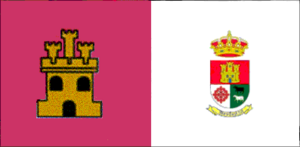Mestanza facts for kids
Mestanza is a small town in Spain. It's located in the province of Ciudad Real, which is part of the Castilla-La Mancha region. The town covers an area of about 370 square kilometers and has around 821 people living there.
Mestanza's area also includes two smaller villages called Hoyo and Solanilla del Tamaral. You can find Mestanza south of Puertollano, nestled in the beautiful Alcudia valley. The Montoro reservoir is nearby, and the town is close to the Sierra Madrona mountains.
The main celebrations in Mestanza happen around July 25 to 29, for San Pantaleón. Another big event is "El Voto" (which means "The Vow"), an old tradition. This is a pilgrimage held on the last Sunday of May each year. During this day, a statue of the Virgin Mary is carried to a small chapel just outside the town.
Ancient Times
People have lived in this area for a very long time, even before recorded history! You can find ancient cave paintings from the Stone Age (Paleolithic period) in rock shelters near Fuencaliente and Solana del Pino.
Closer to Mestanza itself, archaeologists have found old sites like La Tabernera and El Chupón. There are also more ancient paintings in places like Puente Mercedes (El Hoyo).
Roman Times
The Roman Empire had a strong presence here, mainly because of the mines. The Romans mined a lot in a town called Sisapo (now La Bienvenida). This Roman mining area was in the western part of the Alcudia Valley. It was connected to another Roman town, Cástulo (now Linares), to help transport the mined materials. An example of Roman mining is Minas Diógenes, which was even used until the 1970s!
The Romans changed the landscape quite a bit. They cut down many trees to support their mining activities. A famous Roman general named Cayo Mario, who was a consul seven times, even made his fortune from mining in these mountains. That's why some mountains, like Sierra Morena and Sierra Madrona, were named "Sierras Mariánicas" after him.
Middle Ages
During the time of the Muslim kingdoms, there was a Moorish castle where Mestanza is today. A mosque was built around the castle, and the town grew up around them. The name Mestanza actually comes from a Berber word, "Mistasa," which means "mosque."
The Christian king Alfonso VI conquered the town in 1086. Later, the Order of Calatrava, a powerful knightly order, turned this area into a "Royal Dehesa." This meant it was a special royal pasture. For many centuries, the Alcudia Valley was a very important place for sheep to spend the winter. The "Mesta," a big organization for sheep herders, brought their flocks here using many old paths. This is why the coat of arms of Mestanza includes the Cross of the Order of Calatrava, a sheep, and a lamb.
Even today, some families still bring their livestock to the valley in winter, though not as many as before. Modern transport like trains and roads have replaced the old sheep paths. These families, who come from mountain areas like Guadalajara or Soria, are known as "Serranos."
Modern History
In more recent times, Mestanza's economy relied on mining and raising animals, with some hunting too. Mining focused on coal from the late 1800s to the mid-1900s, especially in nearby Puertollano. They also mined galena (a mineral containing lead and silver) in the El Hoyo and Solanilla del Tamaral valleys. This led to a new mining area called Las Navas de Riofrío, which was later abandoned in 1927.
During a time when Spain was isolated from other countries, General Franco's government decided to build a plant in Puertollano to get oil from shale rock. This plant needed a lot of water. So, the Montoro Dam was built to supply water to the industrial plants through a tunnel in the Sierra de Mestanza mountains. General Franco opened the Montoro Dam in 1950. It collects water from the Montoro and Tablillas rivers.
After Spain's isolation ended, the shale oil plant was replaced by a modern oil refinery. This led to the gradual closing of many mines. Today, the open coal mines in Puertollano are mainly used to provide power.
Population Changes
Here's how the population of Mestanza changed over some years:
- 1991: 989 people
- 1996: 1,003 people
- 2001: 890 people
- 2004: 830 people
See also
 In Spanish: Mestanza para niños
In Spanish: Mestanza para niños




